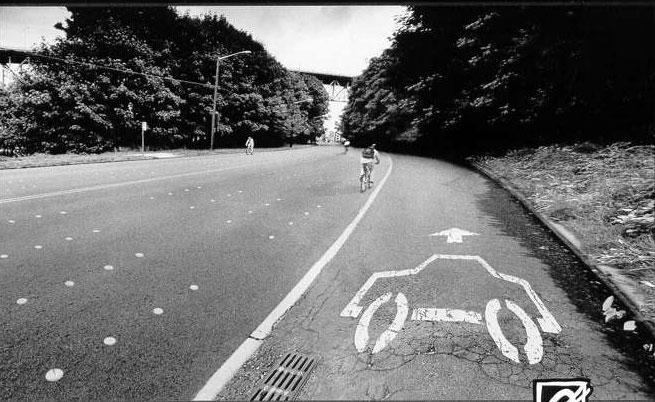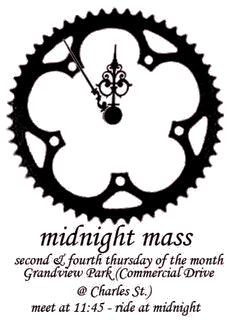Bike lanes prevent over-correction by drivers...
 This is an interesting study. Actually looking at bike lanes in use!? It is interesting to see the goals of the project: more lawful compliance, less disruptions to the path of the car, seem to be the primary goals of the project. The aspect of safety - not riding on the sidewalk - is not really studied but previous ideas are reinforced about it. I think a norrow lane for cars at the side of the road should keep them more lawful. I think even a 4 foot lane would do good. It would help keep them off the sidewalk too. plus prevent cyclists having to swerve so much.
This is an interesting study. Actually looking at bike lanes in use!? It is interesting to see the goals of the project: more lawful compliance, less disruptions to the path of the car, seem to be the primary goals of the project. The aspect of safety - not riding on the sidewalk - is not really studied but previous ideas are reinforced about it. I think a norrow lane for cars at the side of the road should keep them more lawful. I think even a 4 foot lane would do good. It would help keep them off the sidewalk too. plus prevent cyclists having to swerve so much.Bike lanes prevent over-correction by drivers, bicyclists, reducing danger even on narrow roads engr.utexas.edu/news/articles/September 18, 2006
By studying the interactions of drivers and bicyclists on Texas roads, transportation engineers at The University of Texas at Austin have discovered that having painted bike lanes on streets and roads helps both commuters stay in safer, more central positions in their respective lanes.
"Without a marked bike lane, there appears to be a lot of uncertainty about how much space each person needs -- even when adequate road space is provided," said Randy Machemehl, the Nasser I. Al-Rashid Centennial Professor in Transportation Engineering and director of the university's Center for Transportation Research (CTR), where the study was conducted.
The Texas Department of Transportation (TxDOT) provided $114,000 for the study conducted on two- and four-lane roadways where bike lanes had been added. The results are posted at the CTR's Web site at:
www.utexas.edu/research/ctr/pdf_reports/0_5157_1.pdf.
Cities such as Austin, Houston and San Antonio where the study was conducted are considering how to increase bicycle lanes as part of meeting federal requirements of the Clean Air Act. Before the study, little was known about the best approach for adding bike lanes to existing roadways for commuter comfort.
TxDOT follows recommendations from the American Association of State Highway and Transportation Officials to have five-foot-wide bike lanes. However, existing roadways can be too narrow to retrofit that way.
By studying videos of thousands of passing events involving 31 paid, volunteer cyclists, and combining that with data from other studies, CTR researchers determined the best approach for narrower, retrofitted roadways.
Often, four-lane roadways provide 24 feet for traffic moving in one direction. The surface could be re-striped to provide a 10-foot-wide motorists' lane and a 14-foot-wide, outside lane that is unmarked for shared use. Or the outside lane could be marked to clearly show bicyclists have the outer four feet.
Ian Hallett, a CTR graduate research assistant, and David Luskin, a former CTR research scientist, found that cyclists on a road that provided an unmarked, four-foot lane tended to hug the curb dangerously close. Safer cyclist behavior occurred with a striped lane the same width.
Motorists in the outside, 10-foot-wide lane generally behaved similarly. Without a marked bike lane, they veered away from bicyclists, crossing into the next motorist lane nearly nine out of 10 times.
Often, they veered so far in an apparent effort to avoid a collision that they swerved a full four feet into the next motorists' lane.
"You could put a whole car between the bicyclist and them," said Hallett, an avid bicyclist who's logged thousands of miles in Austin.
With a striped bike lane, six of 10 motorists swerved, but those who swerved only encroached about 40 percent as far.
To ensure that the study findings would be broadly applicable, the CTR engineers chose volunteer cyclists of different ages, gender and cycling experience to observe during more than 8,000 passing events. The videotaping occurred last year between February and March.
Taking advantage of Luskin's statistical expertise, the pair then combined the behavioral information from the 120 hours of video with results from a national study of a similar mix of cyclists. That 1998 study for the Federal Highway Administration involved asking hundreds of cyclists how safe they would feel in various road situations shown on film.
"We went out in the field and actually observed what cyclists do out there, and what the situation was for motorists as well to expand on others' work," Luskin said.
The researchers have provided the study's combined results on computer software to inform transportation officials' decisions about bikeway changes.
Previous studies had suggested other benefits of marked bicycle lanes. Some had shown that bicyclists stop at intersections more often and obey general traffic rules better when roadways are marked to include them.
Bicyclists are also less likely to ride on sidewalks when on-street bike lanes exist. When they ride on sidewalks, studies have shown that it increases their accident risk 25 times. This occurs primarily because motorists pulling onto roadways tend to focus on street traffic. As a result, a driver may fail to see sidewalk bicyclists and collide with them when the cyclists cross a driveway where motorists are merging into roadway traffic.
"Bike lanes reinforce the concept that bicyclists are supposed to behave like other vehicles, and make life safer for everyone involved as a result," Hallett said.
For photos of researchers who conducted the CTR study, go to: engr.utexas.edu/...BikeLane
If you are concerned about cycling throughout the Lower Mainland please join the VACC.bc.ca
 Vancouver Critical Mass
Vancouver Critical Mass











0 Comments:
Post a Comment
Please be respectful and constructive. If you want to vent or hate do it somewhere else. Violent, threatening and abusive comments will be removed. Please read other posts and discussion to avoid duplicate questions.
<< Home